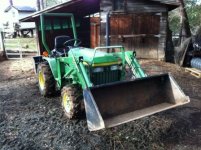Ron JD670
Silver Member
- Joined
- Jan 20, 2012
- Messages
- 143
- Location
- Jacksonville in S. Oregon
- Tractor
- for Cristmas 2011 found used Joh Deere 670 w/ 40 hrs and options
Welll one of my first projects was partially done when it decided to start raining here in Sothern Oregon. I widened the access to my pasture next to my shed to accomodate the new tractor moving material and stall sweepings. The work was in part also needed to keep water from migrating into the hay storage and parking area for the tractor.
After using the FEL to remove material and the box scraper to level, fill in, and slope the new area for water run off - a pretty good job for a newby . I drove over the newly leveled ground a number of time and wetted it in the hopes of getting some compating before the rain. I planned on putting gravel down also before the rain but could not get it delivered yet. So I threw some straw down. The original access walking area is still good/firm in part because it is under the eves of the barn and I only made a light pass with BS to blend in with the new added path. However, the new area I worked has turned into a red clay slip-n-slide
. I drove over the newly leveled ground a number of time and wetted it in the hopes of getting some compating before the rain. I planned on putting gravel down also before the rain but could not get it delivered yet. So I threw some straw down. The original access walking area is still good/firm in part because it is under the eves of the barn and I only made a light pass with BS to blend in with the new added path. However, the new area I worked has turned into a red clay slip-n-slide  ranging from a half inch to two inches deep. The straw helps but has not stablized it. I have avoided taking the tractor over the area as I have heard you can create a mud bath if you are not careful.
ranging from a half inch to two inches deep. The straw helps but has not stablized it. I have avoided taking the tractor over the area as I have heard you can create a mud bath if you are not careful.
I am planning on laying some gravel on the firm stable area, but have no idea what to do with the slip-n-slide. So the question, should I dump gravel on the area and try to spread it? Or leave it alone.
Also I still need to scratch at the red clay (new tooth bar on order) just above this area to prep for a couple post holes to support a wall of rail road ties. Should I abandon this project until spring? :confused2:
Thank you
After using the FEL to remove material and the box scraper to level, fill in, and slope the new area for water run off - a pretty good job for a newby
I am planning on laying some gravel on the firm stable area, but have no idea what to do with the slip-n-slide. So the question, should I dump gravel on the area and try to spread it? Or leave it alone.
Also I still need to scratch at the red clay (new tooth bar on order) just above this area to prep for a couple post holes to support a wall of rail road ties. Should I abandon this project until spring? :confused2:
Thank you
Last edited:

